Ferguson MF8400 User Manual

DECLARATION CE DE CONFORMITE
AVEC ANNEXE POUR REFERENCE A CERTIFICAT DELIVRE PAR
ORGANISME COMPETENT
EC DECLARATION OF CONFORMITY
WITH ANNEX REFERING TO A CERTIFICATE DELIVERED BY
A COMPETENT BODY
Fabriquant : |
AGCO S.A. |
Manufacturer |
|
Adresse : |
Avenue Blaise Pascal, 60026 BEAUVAIS - FRANCE. |
Address |
|
Nom du signataire : |
Jonny Frolli |
Signatory' s name |
|
Qualité : |
Directeur |
Quality |
|
Description du produit : Tracteur agricole
Product description Agricultural tractor
Le produit identifié ci-dessus est déclaré conforme aux dispositions de :
The identified product hereover is declared conform to the requirements of
-La Directive 75/322 modifiée par la Directive 2000/2 du 14 janvier 2000 et la directive 2001/3 du 8 janvier 2001 relative aux tracteurs agricoles ou forestiers à roues.
-Directive 75/322 modified by the Directive 2000/2 from 14 january 2000 and the directive 2001/3 from 8 of january 2001 relating to wheeled agricultural or forestry tractors.
en raison de la délivrance par un ORGANISME COMPÉTENT DU CERTIFICAT EN ANNEXE.
due to the delivrery by a Competent Body of the Certificate in annex.
Lieu : |
Beauvais |
Location |
|
Signature : |
|
Signature |
|
ANNEXE A DECLARATION CE DE CONFORMITE
ANNEX TO A EC DECLARATION OF CONFORMITY
Fabriquant : |
AGCO SA. |
Manufacturer |
|
Adresse : |
Avenue Blaise Pascal, 60026 BEAUVAIS - FRANCE. |
Address |
|
Identification du produit : Tracteur agricole |
|
Product Identification |
Agricultural tractor |
La conformité aux exigences de la Directive 2001/3 est reconnue pour le produit identifié ci-dessus par :
The Conformity to the requirements of the 2001/3 Directive of the hereover identified product is recognised by:
- Organisme compétent : |
UTAC |
Competent body |
|
- Adresse : |
Autodrome de Linas |
Address |
93311 MONTLHÉRY - FRANCE |
qui a delivré le certificat dont les références sont : who delivrered the certificate which references are
- Numéro du certificat : UTAC 04/03805
Certificate number
-Date (Approbation LCIE) : 14/06/04
Date

8400 Series Tractors
For models 8450 - 8460 - 8470 - 8480 Dyna VT |
|
AGCO - SA - Beauvais - France - RC B562 104 539 |
October 2006 |
MASSEY FERGUSON is a worldwide brand of AGCO Corporation |
N° 3378886M1 |
Issue 2
8400 EAME
English

OPERATOR INSTRUCTION BOOK
CONTENTS
Chapter 1
TRACTOR IDENTIFICATION
Chapter 2
INTRODUCTION - SAFETY INSTRUCTIONS AND WARRANTY
Chapter 3
INSTRUMENTS AND CONTROLS
Chapter 4
OPERATION
Chapter 5
MAINTENANCE AND ADJUSTMENTS
Chapter 6
SPECIFICATIONS
Chapter 7
ACCESSORIES AND OPTIONS
Appendix
CONVERSION TABLES
Index
1
2
3
4
5
6
7
8400 EAME

1 . TRACTOR IDENTIFICATION
1
Chapter 1
TRACTOR IDENTIFICATION
8400 EAME |
1.1 |

1 . TRACTOR IDENTIFICATION
CONTENTS
1.1 - SERIAL NUMBER. . . . . . . . . . . . . . . . . . . . . . . . . . . . . . . . . . . . . . . . . . . . . . . . . . . . . . . . . . . . . . . . . . . . . . . . .1.5
1
8400 EAME |
1.3 |

1 . TRACTOR IDENTIFICATION
1.4 |
8400 EAME |

1 . TRACTOR IDENTIFICATION
1.1 - SERIAL NUMBER
IMPORTANT: WHEN CONTACTING YOUR DEALER OR AGENT, ALWAYS INDICATE YOUR TRACTOR SERIAL NUMBER.
Registration plate (according to country)
Z3A-1131-09-
Z3A-1134-09-04
Fig. 1
Name plate with serial number (according to country)
Z3A-1133-09-04
Z3A-1132-09-04
Fig. 2
Front axle serial number
1
Z4A-1631-11-05
Fig. 3
"Sisu" engine serial number
Z4A-1630-11-
Fig. 4
Cab serial number
Z3A-702-07-04
Fig. 5
8400 EAME |
1.5 |

1 . TRACTOR IDENTIFICATION
MODEL:..............................................................................
............................................................................................
SERIAL NUMBER: ..............................................................
............................................................................................
ENGINE SERIAL NUMBER:................................................
............................................................................................
OWNER NAME AND ADDRESS (if applicable):
............................................................................................
............................................................................................
............................................................................................
............................................................................................
............................................................................................
............................................................................................
DEALER: ............................................................................
............................................................................................
............................................................................................
STREET: .............................................................................
TOWN:................................................................................
STATE: ................................................................................
ZIP CODE: ..........................................................................
DEALER CODE: .................................................................
............................................................................................
TRACTOR RECEIVED FROM:
(tick one of the following)
............................FACTORY
............................OTHER DEALER (transfer)
1.6 |
8400 EAME |

2 . INTRODUCTION - SAFETY INSTRUCTIONS AND WARRANTY
2
Chapter 2
INTRODUCTION - SAFETY INSTRUCTIONS AND
WARRANTY
8400 EAME |
2.1 |

2 . INTRODUCTION - SAFETY INSTRUCTIONS AND WARRANTY
CONTENTS
2.1 |
- INTRODUCTION. . . . . . . . . . . . . . . . . . . . . . . . . . . . . . . . . . . . . . . . . . . . . . . . . . . . . . . . . . . . . . . . . . . . . . . . . . |
2.5 |
|
|
|
2.1.1 |
Pre-delivery inspection, commissioning at the user’s premises and warranty . . . . . . . . . . . . . . . . . . . |
2.5 |
|
|
2.1.2 |
Warranty procedure. . . . . . . . . . . . . . . . . . . . . . . . . . . . . . . . . . . . . . . . . . . . . . . . . . . . . . . . . . . . . . . . |
2.6 |
|
|
2.1.3 |
Using the tractor in another region . . . . . . . . . . . . . . . . . . . . . . . . . . . . . . . . . . . . . . . . . . . . . . . . . . . . |
2.6 |
|
|
2.1.4 |
Servicing after the warranty period . . . . . . . . . . . . . . . . . . . . . . . . . . . . . . . . . . . . . . . . . . . . . . . . . . . . |
2.6 |
|
2.2 |
- SAFETY - ALERT SYMBOLS AND TERMS. . . . . . . . . . . . . . . . . . . . . . . . . . . . . . . . . . . . . . . . . . . . . . . . . . . . . |
2.7 |
|
|
2.3 |
- TRACTOR AND IMPLEMENTS . . . . . . . . . . . . . . . . . . . . . . . . . . . . . . . . . . . . . . . . . . . . . . . . . . . . . . . . . . . . . . |
2.7 |
|
|
2.4 |
. . . . . . . . . . . . . . . . . . . . . . . . . . . . . . . . . . . . . . . . . . . . . . . . . . . . . . . . . . . . . . .- MAXIMUM TRAVEL SPEEDS |
2.8 |
2 |
|
2.5 |
- NOTE TO THE OPERATOR . . . . . . . . . . . . . . . . . . . . . . . . . . . . . . . . . . . . . . . . . . . . . . . . . . . . . . . . . . . . . . . . . |
2.8 |
||
2.6 |
- DANGER, WARNING AND CAUTION. . . . . . . . . . . . . . . . . . . . . . . . . . . . . . . . . . . . . . . . . . . . . . . . . . . . . . . . . |
2.8 |
|
|
|
||||
2.7 |
- DECALS |
. . . . . . . . . . . . . . . . . . . . . . . . . . . . . . . . . . . . . . . . . . . . . . . . . . . . . . . . . . . . . . . . . . . . . . . . . . . . . . . . |
2.8 |
|
2.8 |
- SAFETY PROCEDURE TO FOLLOW . . . . . . . . . . . . . . . . . . . . . . . . . . . . . . . . . . . . . . . . . . . . . . . . . . . . . . . . . . |
2.8 |
|
|
|
2.8.1 |
For proper operation . . . . . . . . . . . . . . . . . . . . . . . . . . . . . . . . . . . . . . . . . . . . . . . . . . . . . . . . . . . . . . . |
2.8 |
|
|
2.8.2 |
Observe the following instructions . . . . . . . . . . . . . . . . . . . . . . . . . . . . . . . . . . . . . . . . . . . . . . . . . . . . |
2.9 |
|
2.9 - PROTECTION . . . . . . . . . . . . . . . . . . . . . . . . . . . . . . . . . . . . . . . . . . . . . . . . . . . . . . . . . . . . . . . . . . . . . . . . . . . .2.9
2.9.1 Cab . . . . . . . . . . . . . . . . . . . . . . . . . . . . . . . . . . . . . . . . . . . . . . . . . . . . . . . . . . . . . . . . . . . . . . . . . . . .2.9 2.9.2 Damage to the ROPS cab . . . . . . . . . . . . . . . . . . . . . . . . . . . . . . . . . . . . . . . . . . . . . . . . . . . . . . . . . . .2.9
2.10 - PREPARING FOR SAFE OPERATION . . . . . . . . . . . . . . . . . . . . . . . . . . . . . . . . . . . . . . . . . . . . . . . . . . . . . . . . .2.9
2.10.1 Know your equipment . . . . . . . . . . . . . . . . . . . . . . . . . . . . . . . . . . . . . . . . . . . . . . . . . . . . . . . . . . . . . .2.9 2.10.2 Protect yourself . . . . . . . . . . . . . . . . . . . . . . . . . . . . . . . . . . . . . . . . . . . . . . . . . . . . . . . . . . . . . . . . . . 2.10 2.10.3 Use all available protective and safety devices . . . . . . . . . . . . . . . . . . . . . . . . . . . . . . . . . . . . . . . . . . 2.10 2.10.4 Equipment check. . . . . . . . . . . . . . . . . . . . . . . . . . . . . . . . . . . . . . . . . . . . . . . . . . . . . . . . . . . . . . . . . 2.11 2.10.5 Clean the tractor . . . . . . . . . . . . . . . . . . . . . . . . . . . . . . . . . . . . . . . . . . . . . . . . . . . . . . . . . . . . . . . . . 2.11 2.10.6 Protect the environment . . . . . . . . . . . . . . . . . . . . . . . . . . . . . . . . . . . . . . . . . . . . . . . . . . . . . . . . . . . 2.12
2.11 - SERVICING THE TRACTOR . . . . . . . . . . . . . . . . . . . . . . . . . . . . . . . . . . . . . . . . . . . . . . . . . . . . . . . . . . . . . . . .2.12
2.12 - STARTING . . . . . . . . . . . . . . . . . . . . . . . . . . . . . . . . . . . . . . . . . . . . . . . . . . . . . . . . . . . . . . . . . . . . . . . . . . . . .2.12
2.12.1 Warn personnel before starting. . . . . . . . . . . . . . . . . . . . . . . . . . . . . . . . . . . . . . . . . . . . . . . . . . . . . . 2.12 2.12.2 Get on and off the tractor safely . . . . . . . . . . . . . . . . . . . . . . . . . . . . . . . . . . . . . . . . . . . . . . . . . . . . . 2.12 2.12.3 Start safely. . . . . . . . . . . . . . . . . . . . . . . . . . . . . . . . . . . . . . . . . . . . . . . . . . . . . . . . . . . . . . . . . . . . . . 2.12 2.12.4 Follow recommended start-up procedures . . . . . . . . . . . . . . . . . . . . . . . . . . . . . . . . . . . . . . . . . . . . . 2.13 2.12.5 Controls test . . . . . . . . . . . . . . . . . . . . . . . . . . . . . . . . . . . . . . . . . . . . . . . . . . . . . . . . . . . . . . . . . . . . 2.13 2.12.6 Starting fluid . . . . . . . . . . . . . . . . . . . . . . . . . . . . . . . . . . . . . . . . . . . . . . . . . . . . . . . . . . . . . . . . . . . . 2.13
2.13 - WORKING SAFELY . . . . . . . . . . . . . . . . . . . . . . . . . . . . . . . . . . . . . . . . . . . . . . . . . . . . . . . . . . . . . . . . . . . . . .2.13
2.13.1 Make the right moves . . . . . . . . . . . . . . . . . . . . . . . . . . . . . . . . . . . . . . . . . . . . . . . . . . . . . . . . . . . . . 2.13 2.13.2 Safety instructions to be observed . . . . . . . . . . . . . . . . . . . . . . . . . . . . . . . . . . . . . . . . . . . . . . . . . . . 2.13 2.13.3 Safety of bystanders . . . . . . . . . . . . . . . . . . . . . . . . . . . . . . . . . . . . . . . . . . . . . . . . . . . . . . . . . . . . . . 2.14 2.13.4 Risk of overturning . . . . . . . . . . . . . . . . . . . . . . . . . . . . . . . . . . . . . . . . . . . . . . . . . . . . . . . . . . . . . . . 2.14 2.13.5 To avoid side overturns . . . . . . . . . . . . . . . . . . . . . . . . . . . . . . . . . . . . . . . . . . . . . . . . . . . . . . . . . . . . 2.15 2.13.6 To avoid rear overturns . . . . . . . . . . . . . . . . . . . . . . . . . . . . . . . . . . . . . . . . . . . . . . . . . . . . . . . . . . . . 2.15 2.13.7 Emergency handbrake. . . . . . . . . . . . . . . . . . . . . . . . . . . . . . . . . . . . . . . . . . . . . . . . . . . . . . . . . . . . . 2.16 2.13.8 Other risks . . . . . . . . . . . . . . . . . . . . . . . . . . . . . . . . . . . . . . . . . . . . . . . . . . . . . . . . . . . . . . . . . . . . . . 2.16 2.13.9 Implements and attachments . . . . . . . . . . . . . . . . . . . . . . . . . . . . . . . . . . . . . . . . . . . . . . . . . . . . . . . 2.17 2.13.10 Tractor Towing. . . . . . . . . . . . . . . . . . . . . . . . . . . . . . . . . . . . . . . . . . . . . . . . . . . . . . . . . . . . . . . . . . . 2.18 2.13.11 Road use . . . . . . . . . . . . . . . . . . . . . . . . . . . . . . . . . . . . . . . . . . . . . . . . . . . . . . . . . . . . . . . . . . . . . . . 2.18 2.13.12 Highway code . . . . . . . . . . . . . . . . . . . . . . . . . . . . . . . . . . . . . . . . . . . . . . . . . . . . . . . . . . . . . . . . . . . 2.18
2.14 - SAFETY - AFTER OPERATION . . . . . . . . . . . . . . . . . . . . . . . . . . . . . . . . . . . . . . . . . . . . . . . . . . . . . . . . . . . . .2.19
2.15 - DESCRIPTION OF DECALS . . . . . . . . . . . . . . . . . . . . . . . . . . . . . . . . . . . . . . . . . . . . . . . . . . . . . . . . . . . . . . . .2.20
8400 EAME |
2.3 |

2 . INTRODUCTION - SAFETY INSTRUCTIONS AND WARRANTY
2.4 |
8400 EAME |

2 . INTRODUCTION - SAFETY INSTRUCTIONS AND WARRANTY
2.1 - INTRODUCTION
The Safety chapter in the Operator Instruction Book stresses certain basic safety-related situations which may be encountered during the operation and normal servicing of the tractor and gives the information needed to cope with these situations. This chapter SUPPLEMENTS any safety instructions given in other chapters of this book.
It may be necessary to take additional precautions depending on the equipment used and the working conditions on the site or in the servicing area. AGCO can under no circumstances exercise direct control over the commissioning, operation, inspection, lubrication or servicing of the tractor. It is therefore YOUR responsibility to take suitable safety measures in such areas.
NOTE: This book is published and distributed worldwide and the availability of the equipment indicated, whether on the basic tractor or as accessories, may vary according to the country in which the tractor is used. To find out which equipment is available in a given region, contact an AGCO dealer.
The purpose of this book is to allow the owner and the operator to run the tractor safely. Providing they follow the instructions carefully, the tractor will operate for many years in the AGCO tradition.
Commissioning the equipment at the user’s by the dealer provides the possibility of ensuring that these operating and servicing instructions are properly understood. Always consult the dealer if any part of this book is not understood. It is important for these instructions to be understood and followed.
Daily maintenance should become a routine and a log book of operating hours should be kept.
When new spare parts are required, it is important to use AGCO original spare parts only. AGCO dealers supply only genuine original parts and can give advice concerning their fitting and use.
The use of parts of lower quality may cause serious damage. Customers are advised to only purchase their spare parts from an approved AGCO dealer.
Due to the considerable differences in operating conditions, it is not possible for the manufacturer to formulate complete or absolute assertions in its publications concerning the performance or operating methods of its machines or accept liability for any loss or damage which may result from such assertions or possible errors or omissions.
To prevent the warranty becoming void, you should consult your AGCO dealer to obtain special instructions if the tractor is to be used under abnormal conditions which could be detrimental to it (use in deep water or in paddy fields for instance).
These tractors are only designed for usual farming purposes (designed use).
Any other use is considered as being contrary to the designed use. AGCO declines all liability in cases of physical damage or injuries resulting from improper use the consequences of which shall be borne by the user alone.
The conformity and strict adherence to the operating, servicing and repair requirements specified by AGCO are also essential factors for designed use.
These tractors must only be used, serviced and repaired by personnel having full knowledge of their specific features and who are aware of the applicable safety rules (prevention of accidents).
Customers are strongly recommended to contact an AGCO dealer in the event of after-sale problems and for any adjustments which may be necessary.
2.1.1- Pre-delivery inspection, commissioning at the user’s premises and warranty
When selling new products to their dealers, the manufacturer gives a warranty which, subject to certain conditions,
guarantees that the goods are free from defects in material 2 and workmanship. Since this book is published worldwide,
it is impossible to detail the exact terms and conditions of warranty that apply to a retail customer in any particular country.
Purchasers of new AGCO equipment should request full details from their supplying Dealer.
In accordance with the Corporation's policy of continuous improvement to its products, alterations in the specifications of machines may be made at any time without notice. The Corporation disclaims all liability for discrepancies which may occur between the specifications of its products and the descriptions thereof contained in its publications.
A Dealer is required to carry out certain activities when supplying a new AGCO tractor. These consist of a full pre-de- livery inspection to ensure that the tractor supplied is ready for immediate use, and full instructions to the user in the basic principles of operation and servicing of the tractor. These instructions will cover instruments and controls, and routine servicing and safety precautions. All persons who will be concerned with the operation and servicing of the tractor should be present for these instructions.
NOTE: AGCO disclaims all liability to any claim resulting from the fitting of non-approved parts, accessories, implements or equipment or unauthorised modification or alteration.
8400 EAME |
2.5 |

2 . INTRODUCTION - SAFETY INSTRUCTIONS AND WARRANTY
2.1.2 - Warranty procedure
Correct commissioning at the user’s premises and routine servicing contribute to preventing breakdowns. However, if operating problems do occur during the warranty period, follow this procedure:
Immediately inform the dealer you purchased the tractor from, indicating the model and serial number. It is very important not to wait and it should be realised that, even if the defect is covered by the original warranty, the risk coverage may no long apply if the repair is not carried out immediately.
Provide the dealer with as much information as possible. The dealer will need to know how many hours the tractor has been in service, what type of work it is used for and the symptoms of the problem.
It should be noted that routine servicing operations such as tuning, brake and clutch adjustment, and the supplies used for the tractor servicing (oil, filters, fuel and antifreeze) are not covered by the warranty.
Warning concerning spare parts
Parts other than AGCO parts are likely to be of lower quality. AGCO disclaims all liability in the event of loss or damage arising as a result of such parts being fitted. The manufacturer’s warranty may also become void, if such parts are fitted during the normal warranty period.
2.1.3 - Using the tractor in another region
Only the AGCO dealer from whom the tractor was purchased is liable for the protection provided by the warranty. Any repairs required should always, wherever possible, be carried out by this dealer. If, however, the owner moves to another region or if the tractor is to be used temporarily a long way from the dealer it was bought from, it is recommended to ask this dealer for the name and address of the AGCO dealer nearest the customer’s new address and arrange to have the obligations remaining to be fulfilled under the warranty transferred to this dealer.
If the customer leaves the region covered by the original dealer without having taken these steps, the new dealer will offer its services if need be, but may bill them at the normal rate unless:
•the user has effectively specified that the warranty period has not expired and,
•the repair dealer has been given the possibility of taking the necessary steps with the selling dealer.
2.1.4 - Servicing after the warranty period
During the warranty period, all maintenance and repair work must be carried out by the AGCO dealer who will carefully carry out detailed checks of the progress and performance of the new tractor.
To obtain best results from an AGCO tractor, it is important to continue regular servicing and periodic inspection after the warranty has expired. All major overhaul work on the tractor must be carried out by a local AGCO dealer; an experienced technician will detect any problems which may arise between two overhauls.
Mechanical staff regularly follow training courses to update their knowledge of the product, maintenance and repair techniques and the use of special modern tools and equipment for troubleshooting. They receive regular Service Bulletins and have access to all the workshop manuals and technical publications required to carry out repairs or maintenance meeting the quality standards required by AGCO.
2.6 |
8400 EAME |

2 . INTRODUCTION - SAFETY INSTRUCTIONS AND WARRANTY
2.2- SAFETY - ALERT SYMBOLS AND TERMS
This Safety Alert Symbol means CAUTION! BE ALERT! YOUR SAFETY DEPENDS ON IT!
SAFETY is essential! Why?
The safety alert symbol identifies important safety messages on machines, safety signs, in manuals, or elsewhere. When you see this symbol, be alert to the risk of personal injury or death. Follow the instructions in the safety message.
2
•ACCIDENTS DISABLE AND KILL
•ACCIDENTS ARE COSTLY
•ACCIDENTS CAN BE AVOIDED
2.3- TRACTOR AND IMPLEMENTS
The tractor is a source of power - Mechanical - Hydraulic
•On its own, the tractor is of little practical value. Only when used in conjunction with an implement or other attachment does it become a working unit.
•This Operator Instruction Book is compiled to cover the safe working practices when the tractor runs under normal conditions.
•It does not cover all operation and safety instructions relevant to all known implements and attachments that may be fitted at the time of tractor delivery or later.
•It is essential that operators use and understand the relevant instruction books of such implements and attachments.
8400 EAME |
2.7 |
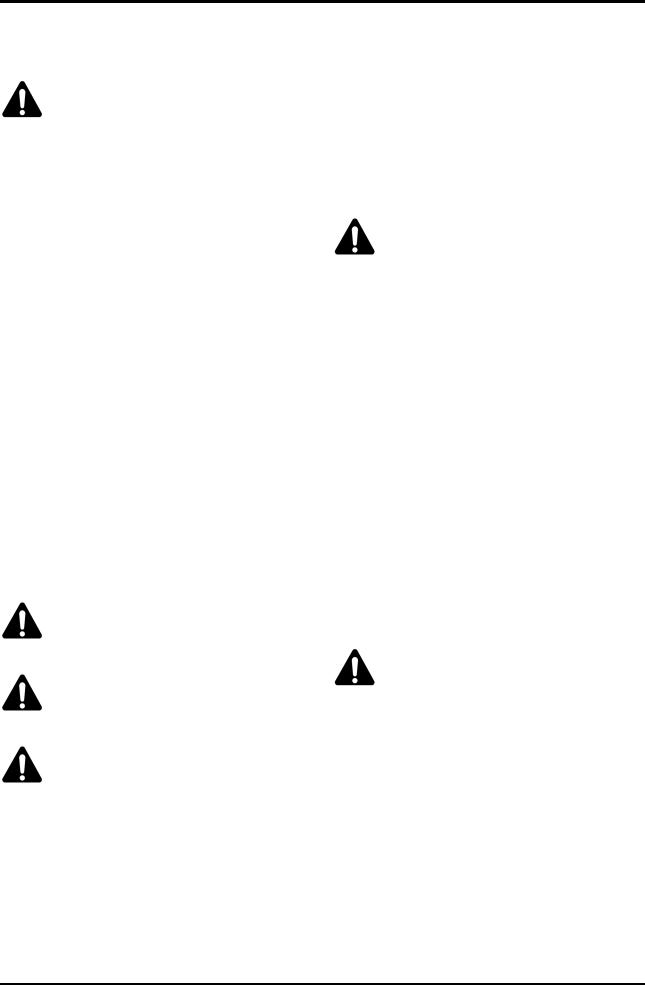
2 . INTRODUCTION - SAFETY INSTRUCTIONS AND WARRANTY
2.4 - MAXIMUM TRAVEL SPEEDS
DANGER: Road use of agricultural tractors is subject to speed restrictions depending on the bulkiness of the equipment and weight of the transported load. Consult the regulatory
texts in force in the relevant countries.
IMPORTANT: Indicates a special instruction or procedure that, if not strictly observed may cause damage to, or destruction of the machine, the process, or the surroundings.
NOTE: The word NOTE indicates additional information about a subject or procedure for more efficient or convenient operation or repair.
2.5 - NOTE TO THE OPERATOR
It is YOUR responsibility to read and understand the Safety chapter in this book before starting your tractor. You must follow these safety instructions that take you step by step through your working day.
In reading this section, you will note that illustrations have been used to highlight certain situations. Each item illustrated is numbered and the same number appears in the text, in parentheses. This number is placed at the end of the written text that refers to the item illustrated.
Remember that YOU are the key to safety. Good safety practices not only protect you, but also bystanders. Study the features in this book with care and make them a working part of your safety program. Keep in mind that this safety section is written only for this type of machine. Also study the usual protective measures taken when working and in particular -
REMEMBER THAT SAFETY DEPENDS ON YOU. YOU CAN PREVENT SERIOUS INJURY OR DEATH.
2.6 - DANGER, WARNING AND CAUTION
Whenever you see the words and symbols shown below, used in this book and on decals, you MUST apply their instructions as they relate to personal safety.
DANGER: This signal, displayed with the word DANGER, indicates an imminently hazardous situation that, if not avoided, may result in DEATH OR VERY SERIOUS INJURY.
WARNING: This signal, displayed with the word WARNING, indicates a potentially hazardous situation that, if not avoided, may result in DEATH OR SERIOUS INJURY.
CAUTION: This signal, displayed with the word CAUTION, indicates a potentially hazardous situation that, if not avoided, may result in MINOR INJURY.
2.7 - DECALS
WARNING: DO NOT remove or obscure DANGER, WARNING, CAUTION or Instruction Decals.
Replace any Danger, Warning, Caution or Instruction Decals that are not readable or are missing. Replacement decals are available from your Dealer in the event of loss or damage. The actual location of these Safety Signs is illustrated at the end of this chapter.
If a used tractor has been purchased, refer to the illustrations at the end of this book to ensure that all the safety signs are in the correct position and are readable.
2.8 - SAFETY PROCEDURE TO FOLLOW
2.8.1 - For proper operation
For proper operation of an agricultural tractor, you must be a qualified and approved operator. To be qualified you must understand the written instructions supplied in this manual, have training, and know the safety rules and regulations for the job.
Some regulations specify that no one under the age of 16 years, for example, may operate power machinery. This includes tractors. It is your responsibility to know what these regulations are, and respect them, in the operating area or situation.
These will include, but are not limited to, the following instructions for safe tractor operation.
WARNING: The operator must not drink alcohol or take any medication that may affect his concentration or coordination. If taking medication, whether prescribed or not, the opera-
tor must seek medical advice as regards his ability to safely operate machinery.
2.8 |
8400 EAME |
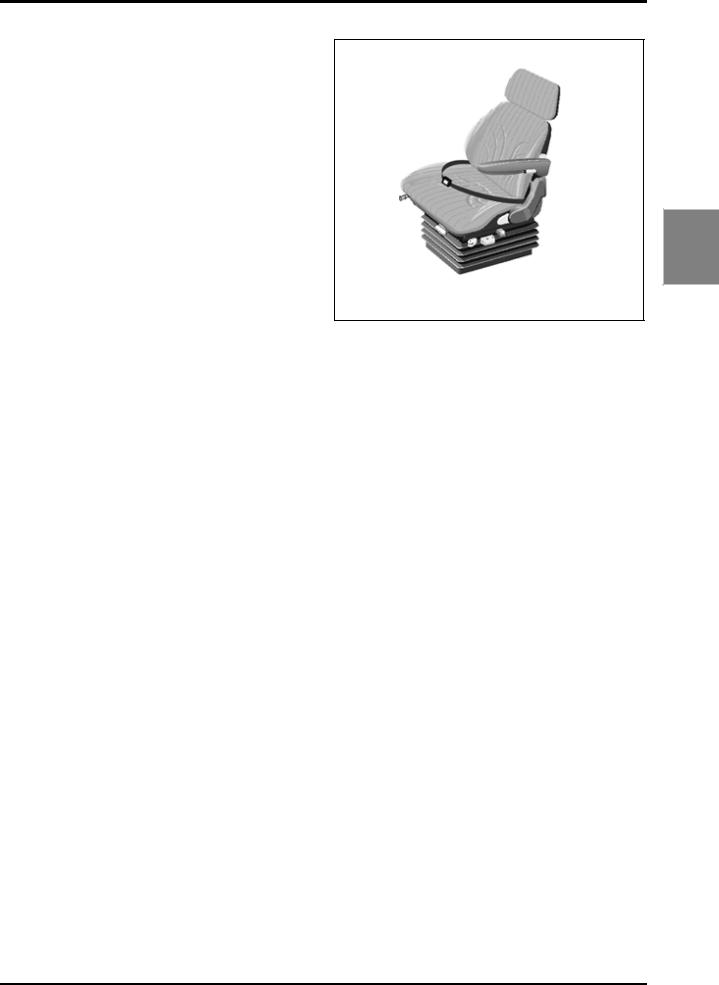
2 . INTRODUCTION - SAFETY INSTRUCTIONS AND WARRANTY
2.8.2 - Observe the following instructions
•DO NOT ALLOW children or unqualified persons to operate your tractor. Keep others away from the working area.
•Always wear your seat belt securely fastened.
•Where possible, avoid operating the tractor near ditches, embankments and holes. Reduce speed when turning, crossing slopes, and on rough, slippery, or muddy surfaces.
•Stay off slopes too steep for safe operation.
•Watch where you are going, especially at row ends, on roads, and around trees.
•Instructor seat is only intended for short periods of use
•Do not allow children in the instructor seat.
•DO NOT PERMIT others to ride on the tractor or the implement unless an approved instructor seat is fitted.
•Only hitch attachments and implements to the drawbar and hitch points recommended, and never above the centre line of the rear axle.
•Operate the tractor smoothly - no jerky turns, starts or stops. When the tractor is stopped, apply the handbrake securely. Lower the implement and remove the ignition key.
•DO NOT MODIFY OR REMOVE any part of the equipment and DO NOT USE attachments unless they are properly matched to your tractor.
2.9 - PROTECTION
2.9.1 - Cab
The ROPS (Roll Over Protective Structure) cab has been designed for this tractor series and meets all the safety and sound legal requirements.
The ROPS cab conforms to the various international safety standards. The ROPS cab must NEVER be drilled or modified to install attachments or implements. Welding on cab components IS NOT PERMITTED. DO NOT ATTACH chains or ropes to the main frame of the cab for pulling purposes.
If additional controls or displays are to be added to the operator’s area contact your AGCO dealer for information. The ROPS cab together with the seat belt is effective in reducing injuries during overturn accidents. Wearing the seat belt is an important part of this protection.
•Always wear your seat belt adjusted snugly.
•Check the seat belt for damage. A damaged seat belt must be replaced (Fig. 1).
2
Z2-529-05-03
Fig. 1
2.9.2 - Damage to the ROPS cab
If the ROPS cab has been damaged as a result of tractor rollover or incident, it must be replaced, NOT repaired. DO NOT use the tractor with a damaged ROPS cab.
2.10 - PREPARING FOR SAFE OPERATION
2.10.1 - Know your equipment
It is important to know the tractor and operation of all its accessories, implements and additional equipment. It is also important to know how to use all the controls, gauges and dials, as well as the rated load capacity, speed range, braking and steering characteristics, turning radius, and operating clearances.
Remember that rain, snow, ice, loose gravel, soft ground, etc. can change the performance of your tractor.
Under poor conditions, slow down and be extra careful, and engage four-wheel drive if fitted.
Study the DANGER, WARNING and CAUTION safety symbols on your tractor and the information signs also.
8400 EAME |
2.9 |

2 . INTRODUCTION - SAFETY INSTRUCTIONS AND WARRANTY
READ THIS OPERATOR INSTRUCTION BOOK CAREFULLY BEFORE STARTING THE ENGINE.
STUDY IT BEFORE YOU START WORK (Fig. 2).
Z2-530-05-03
Fig. 2
Z2-531-05-03 |
Fig. 3 |
|
Learn where fire extinguishers and first-aid or emergency equipment is kept and where to get help in a hurry. Make sure you know how to use this equipment (Fig. 4).
IF THERE IS SOMETHING IN THE BOOK YOU DON’T UNDERSTAND, ASK SOMEONE (for example your equipment dealer) TO EXPLAIN IT TO YOU.
This book covers general safety practice for agricultural tractors. It must always be kept with the tractor. For extra copies contact your AGCO Dealer.
2.10.2 - Protect yourself
Wear all protective clothing and equipment provided or which is appropriate for certain working conditions. Do not take any risks (Fig. 3).
For example, you may need:
•A safety helmet.
•Goggles, or a face shield.
•Hearing protection.
•Respirator or filter mask.
•Inclement weather clothing.
•Reflective clothing.
•Heavy gloves (neoprene for chemicals, leather for rough work).
•Safety shoes.
DO NOT wear loose clothing, jewellery or other items and tie up long hair which could catch on controls or other parts of the equipment.
Fig. 4
2.10.3 - Use all available protective and safety devices
Keep all protective devices correctly attached in their correct places. Ensure that all protective devices, guards and safety signals are fitted as required and are in a good condition.
To help keep you and others around you safe, your tractor should be equipped with:
•Seat belt.
•PTO shield
Your tractor may also need:
•Rear view mirror
•Fire extinguisher
•Emergency warning triangle, guards, backup alarm, lighting devices and decals.
2.10 |
8400 EAME |

2 . INTRODUCTION - SAFETY INSTRUCTIONS AND WARRANTY
It is important to know and use the devices which allow for safe operation of the tractor. Make sure all required equipment is in place and in good working order. DO NOT REMOVE OR DISCONNECT any safety device.
2.10.4 - Equipment check
Before you begin your working day, take time to check your tractor and ensure that all systems are in good operating condition.
•DO NOT SMOKE while refuelling the tractor. Keep any type of naked flame away (Fig. 5).
•Stop the engine and wait for it to cool before refuelling.
|
Fig. 5 |
|
|
Z2-532-05-03 |
|
|
|
•Check for loose, broken, missing, or damaged parts. Have everything put into good repair. Make certain all safety devices are in place.
•Check the seat belt for damage. A damaged seat belt must be replaced.
•Check that all implements and equipment are correctly fitted and that the tractor and implement PTO ratios (rpm) are respected.
•Check the condition and pressure of tyres (absence of cuts and bulges). Replace worn or damaged tyres. Check the hand and foot brake operation. Adjust if necessary.
•Check the oil level. Add some oil if necessary.
•Perform all maintenance procedures outlined in the Maintenance and Adjustments chapter in this Guide.
•Check that the PTO shaft locking devices are latched.
•Check that the tractor PTO shield and shaft guards are in place and operating properly.
•Check the tractor and implement hydraulic system. Have any leaks or damaged parts repaired or replaced.
WARNING: Diesel fuel or hydraulic fluid under pressure can penetrate the skin or eyes and cause serious personal injury, blindness or death.
Fluid leaks, under pressure, may not be visible. Use a piece of cardboard or wood to detect leaks. DO NOT USE YOUR BARE HANDS. Wear safety goggles for eye protection. If any fluid is injected into the skin, it MUST be surgically removed within a few hours by a doctor familiar with this type of injury (Fig. 6).
2
D-58 42A
Fig. 6
Before applying pressure to the fuel or hydraulic system, be sure all connections are tight and that lines, pipes, and hoses are not damaged. Before disconnecting fuel or hydraulic lines, be sure to relieve all pressure.
Make sure that all hydraulic lines are correctly installed and not crossed.
WARNING: Liquid cooling systems build up pressure as the engine gets hot. Before removing the radiator cap, stop the engine and let the system cool.
•Check the engine cooling system and add coolant as required.
2.10.5 - Clean the tractor
•Keep work surfaces and engine compartments clean.
•Before cleaning the machine, always lower implements to the ground, place transmission in neutral, engage the handbrake, stop the engine and remove the ignition key.
•Clean footsteps, pedals and floor. Remove grease or oil. Brush away dust or mud. In winter, scrape away snow and ice. Remember - slippery surfaces are hazardous.
•Remove or put away implements, buckets, chains and hooks.
8400 EAME |
2.11 |
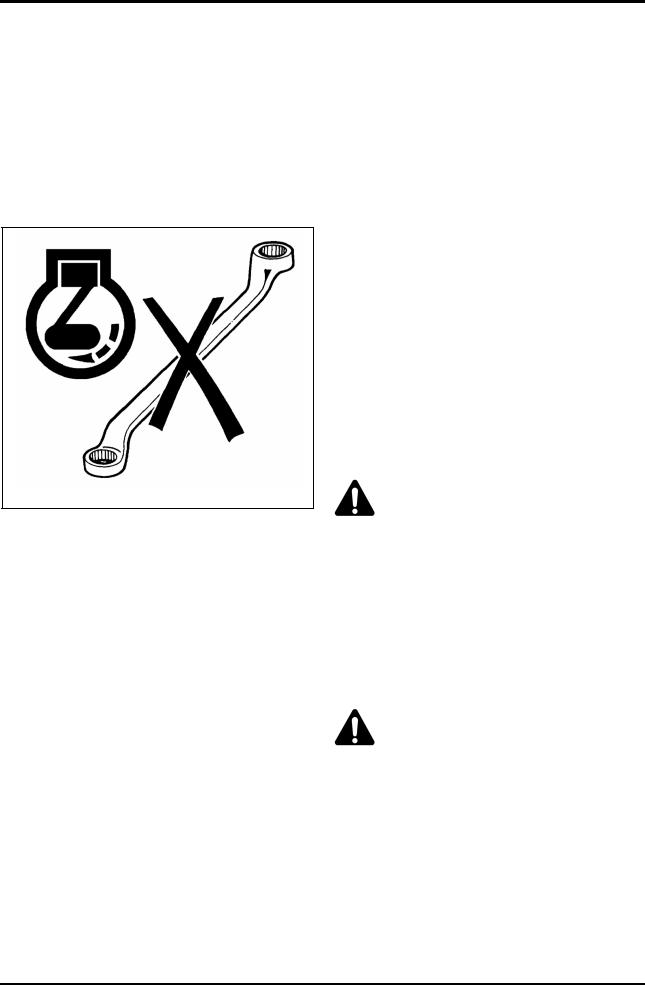
2 . INTRODUCTION - SAFETY INSTRUCTIONS AND WARRANTY
2.10.6 - Protect the environment
•It is illegal to pollute drains, water courses or soil. Use authorised waste disposal facilities, including civic amenity sites and garages providing facilities for disposal of used oil. If in doubt, contact your local authority for advice.
2.11 - SERVICING THE TRACTOR
•DO NOT SERVICE the tractor while the engine is running or hot, or if the tractor is in motion (Fig. 7).
Z2-534-05-03
Fig. 7
•Before making adjustments to or servicing the electrical system, disconnect the battery cables, negative (-) cable first.
•To prevent fires or explosions keep open flame away from the battery or cold weather starting aids. To prevent sparks which could cause explosions use jumper cables according to instructions.
•When making repairs or adjustments it is recommended that you consult your AGCO Dealer, and have the work carried out by trained personnel.
•The implement and/or tractor must be supported on suitable blocks or stands, NOT a hydraulic jack.
•Check all nuts and bolts periodically for tightness, especially wheel hub and rim nuts. Tighten to the prescribed torque values.
2.12 - STARTING
2.12.1 - Warn personnel before starting
Before starting, walk completely around the tractor and any attached equipment. Make sure that no one is under it, on it, or close to it. Tell other workers or people nearby that the tractor is about to start. Do not start the tractor while there are people near the tractor, tools or trailed implements.
Ensure that all bystanders, particularly children, are a suitable distance away before starting the engine.
2.12.2 - Get on and off the tractor safely
Always use "three point contact" with the machine, and face the machine when you get on it. (Three point contact means both hands and one foot or one hand and both feet are in contact with the machine at all times when getting on and off).
Clean your shoes and wipe your hands before getting on. Use handrails, grab handles, ladders or footsteps (as provided) when getting on and off.
DO NOT use control levers as a hand hold and never step on pedals when getting on and off.
DO NOT attempt to get on or off a moving tractor. DO NOT JUMP off a tractor other than in an emergency.
2.12.3 - Start safely
WARNING: Before starting the engine make sure there is plenty of ventilation. DO NOT operate the engine in a closed building. The exhaust fumes may cause asphyxiation.
Always start the engine from the driver’s seat with all the transmission levers and the PTO lever in neutral.
Make sure that the tractor dual brake pedals are locked together at all times unless you are making turns in the field which require independent use of the brakes. Make sure the brakes are properly adjusted so that both brakes engage at the same time.
Adjust the seat, fasten the seat belt (as specified in the book), apply the handbrake and put all controls in neutral before starting up.
DANGER: Start the engine, with the ignition key, from the driver’s seat only. DO NOT ATTEMPT to start the engine by shorting across the starter terminals. The machine will
start in gear if the neutral start circuit is bypassed. This could cause serious injury or death to anyone in the vicinity of the tractor (Fig. 8).
2.12 |
8400 EAME |
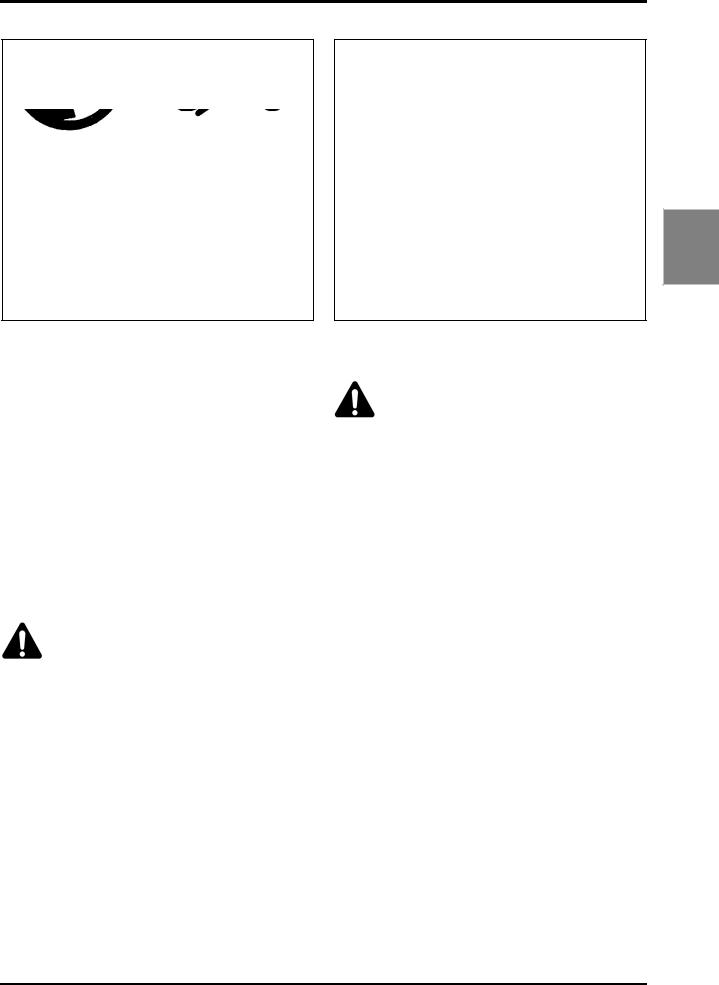
2 . INTRODUCTION - SAFETY INSTRUCTIONS AND WARRANTY
Z2-535-05-03
Fig. 8
2.12.4 - Follow recommended start-up procedures
Follow the start-up procedures recommended in the Operation chapter of this Operator instruction Book. This chapter includes normal starting, cold starting, and the use of starting fluids.
2.12.5 - Controls test
After starting, check all gauges and lights again. Make sure everything is functioning correctly. If the tractor does not respond correctly when each control is operated, DO NOT USE the machine until the fault is remedied.
Ensure that the starter solenoid cover is always in position.
2.12.6 - Starting fluid
WARNING: It is very important that you read and follow the starter fluid instructions before using it. DO NOT use aerosol cans of starter fluid on tractors with the thermostat con-
nected to the electrical system. Ether combined with thermostat can cause an explosion with damage to engine, personal injury, or both.
2
WC1952
Fig. 9
2.13 - WORKING SAFELY
WARNING: An unbalanced tractor could overturn and cause injury or death.
Make sure front frame counterweights, wheel weights and wheel ballast are used as recommended by the manufacturer. DO NOT add extra counterweights to compensate for an overloaded tractor; it is recommended to reduce the load. Keep all parts of
your body inside the cab while operating the tractor.
2.13.1 - Make the right moves
Ensure that the tractor is ready for the work to be carried out. Make sure you know the tractor nominal load capacities and never exceed them. Be certain that any attachments or implements you intend to use DO NOT EXCEED the load rating of your tractor. Be sure the tractor and implement PTO speed match.
Keep in mind that tractors normally operate on uneven, unpaved, and often bumpy or sloping surfaces. Operating conditions can reduce the amount of weight you should carry or pull.
Handle starting fluid correctly. Starting fluid must only be used in conjunction with an ether-start aid fitted as original equipment by the manufacturer or installed by a Dealer as an accessory. In cases of tractors being fitted with glow plugs or a thermostat, these must be removed prior to the installation of an ether-start aid (Fig. 9).
If aerosol cans of starting fluid are to be used the thermostat must be disconnected. Remove the wire from the thermostat which will be found on the manifold. Tape the end of the wire to prevent an electrical short circuit.
2.13.2 - Safety instructions to be observed
•Operate the controls smoothly - don’t jerk the steering wheel or other controls.
•NEVER get on or off a moving tractor. Keep a firm grip on the steering wheel at all times, with the thumbs clear of the spokes when driving the tractor.
•Make sure you have adequate clearance in all directions for the tractor and implement.
•DO NOT play with a tractor or equipment. Use only for intended purpose.
•DO NOT attempt to work the controls except from the driver’s seat.
8400 EAME |
2.13 |
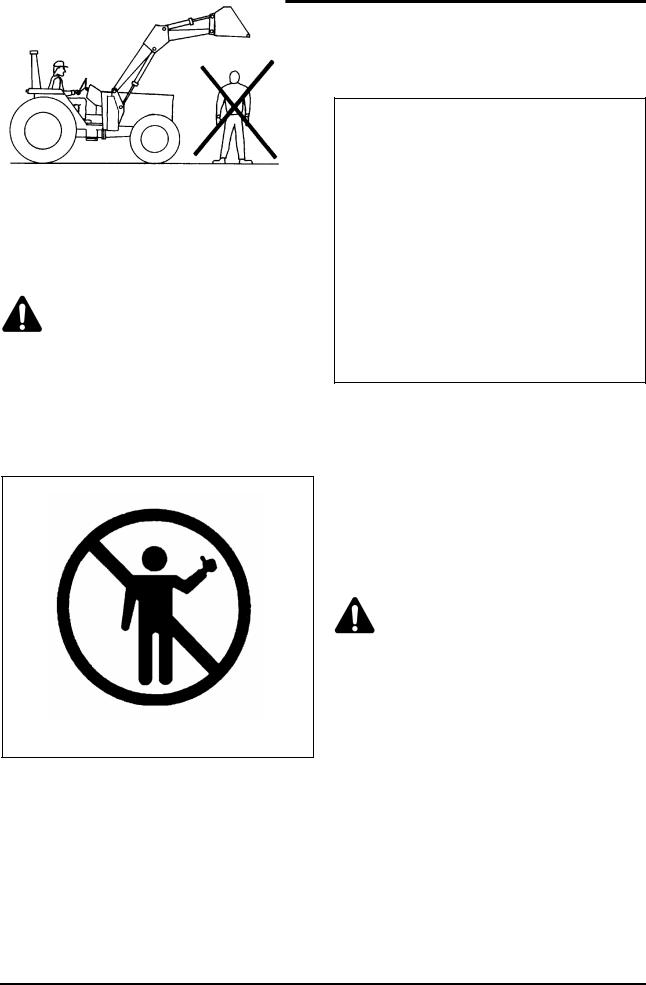
2 . INTRODUCTION - SAFETY INSTRUCTIONS AND WARRANTY
•Before getting off, always disengage the PTO, lower all attachments and implements to the ground, set the tractor to neutral, activate the ParkLock, stop the engine and remove the ignition key.
NOTE: DO NOT TOUCH, lean on, or reach through any implement mechanism or permit others to do so.
Stay alert! If a part breaks, loosens or does not operate correctly, stop work, switch off the engine, check the machine and carry out any necessary adjustments or repairs before resuming work.
2.13.3 - Safety of bystanders
Watch out for others. DO NOT allow inexperienced or unqualified people to operate the tractor. They may cause injury to themselves or to others.
WARNING: A tractor is a personal piece of machinery. Do not allow others to drive the tractor or to use the implement (Fig. 10). DO NOT ALLOW another person to get on the
implements or any other equipment, including trailers, except in the case of harvesters specially designed for this purpose (for the harvest itself and not for transport purposes). Space should be provided on such equipment so that this type of transport can be carried out in complete safety. DO NOT ALLOW children on the tractor.
Z2-536-05-03
Fig. 10
•Be certain you can control both speed and steering before moving. Move slowly until you are sure that everything is operating properly. After starting, recheck the steering, right and left. Be certain you have full steering and brake control. If differential is locked, DO NOT operate at high speed or turn the tractor until the differential lock is disengaged.
•DO NOT LIFT a load over anyone.
•Keep others away from the working area. DO NOT ALLOW others to stand beside or walk beneath a raised implement (Fig. 11).
S-1125
Fig. 11
•DO NOT lift objects that do not fit safely into the bucket. Obtain the correct equipment.
•When using a loader, avoid sudden stops, starts, turns, or change of direction. Keep loads close to the ground when transporting.
•DO NOT stand (or allow anyone else to stand) in front of, under, or behind loaded or loading equipment. DO NOT DRIVE a tractor up to someone standing in front of a fixed object.
•Keep others away from universal joints, hitches, drawbars, lift arms, PTO shafts, cylinders, belts, pulleys, and other moving parts. Keep all shields and guards in place.
WARNING: DO NOT STAND, or allow anyone else to stand, between the tractor and implement unless the engine is turned off and the handbrake is engaged, the transmission con-
trol lever is in neutral, and all attachments or implements are lowered to the ground.
2.13.4 - Risk of overturning
In the event of an overturn with a tractor fitted with a cab, hold the steering wheel firmly and do not attempt to leave the seat until the tractor has come to a standstill (Fig. 12). If the doors of the cab are obstructed, leave through the rear window or roof hatch.
2.14 |
8400 EAME |

2 . INTRODUCTION - SAFETY INSTRUCTIONS AND WARRANTY
Z2-538-05-03
Fig. 12
Fig. 13: Do not operate near the edge of ditches or banks. The distance from the edge should always be equal to or greater than the height of the bank, to prevent it from collapsing.
S-1031
Fig. 13
2.13.5 - To avoid side overturns
•Set the wheel track at the widest setting suitable for the work being done.
•Lock the brake pedals together before driving at transport speeds.
•Reduce speed to match operating conditions. If the tractor is equipped with a front-end loader, carry the bucket and load as low as possible.
•Make wide slow turns at reduced speed. Don’t let your tractor bounce. You may lose steering control.
•Don’t pull a load too heavy for your tractor. It could run down the slope or the tractor could jackknife around a towed load.
•Don’t brake suddenly. Apply brakes smoothly and gradually.
•When driving down a slope, use the gas control to slow the tractor engine and choose the same gear ratio as used when climbing a slope. Shift into gear before you start downhill.
•Engage four-wheel drive (if fitted), this will give fourwheel braking.
WARNING: DO NOT disengage the clutch or attempt to shift gear after you have started downhill.
•The tractor is less likely to turn over if you drive up or down a steep slope rather than driving across it.
• Avoid steep slopes whenever possible. If this is not pos- |
2 |
sible, avoid holes and dips when driving downhill. Avoid |
|
stumps, stones, bumps and raised areas when driving |
|
uphill. Keep the tractor behind the shear line when |
|
|
|
working close to ditches or banks. (Fig. 13). Avoid |
|
ditches, banks and riversides which might give way. |
|
•When you must drive on a steep slope, avoid turning at the top of the slope. Slow down and turn in a wide turning circle. Drive straight on uphill or downhill slopes, and never drive across them. Keep the heavier end of the tractor facing towards the top of the slope when driving up and down it.
•If a tractor fitted with lateral implements is used on a steep slope, the implement must always face up the slope. Do not raise implements. Keep them as low to the ground as possible when crossing a slope.
•When towing a load at transport speed, lock the drawbar in the centre position and use a safety chain.
•DO NOT use your tractor to round up farm animals.
2.13.6 - To avoid rear overturns
WARNING: Hitching to the rear axle, or any other point above the swinging drawbar, can cause a rear overturn.
•DO NOT PULL anything using the top link connection, or from any point on the rear axle or above. Always use an approved AGCO drawbar, and only use a drawbar pin of the correct size and that can be locked in place.
•High hitching can cause rear overturn, which may cause serious injury or death. Hitch loads to the drawbar only.
•Only use a three-point linkage drawbar when stays are fitted to keep it in the down position.
•Use front counterweights to increase tractor stability when towing a heavy load or to counterbalance a heavy rear mounted implement.
•Start forward slowly and gradually increase your speed. DO NOT reverse or release the clutch. If the tractor is attached to a heavy load or immovable object, improper clutching may cause rear overturn.
•If the front end of the tractor starts to lift, reduce your speed and, if necessary, disengage the clutch.
8400 EAME |
2.15 |
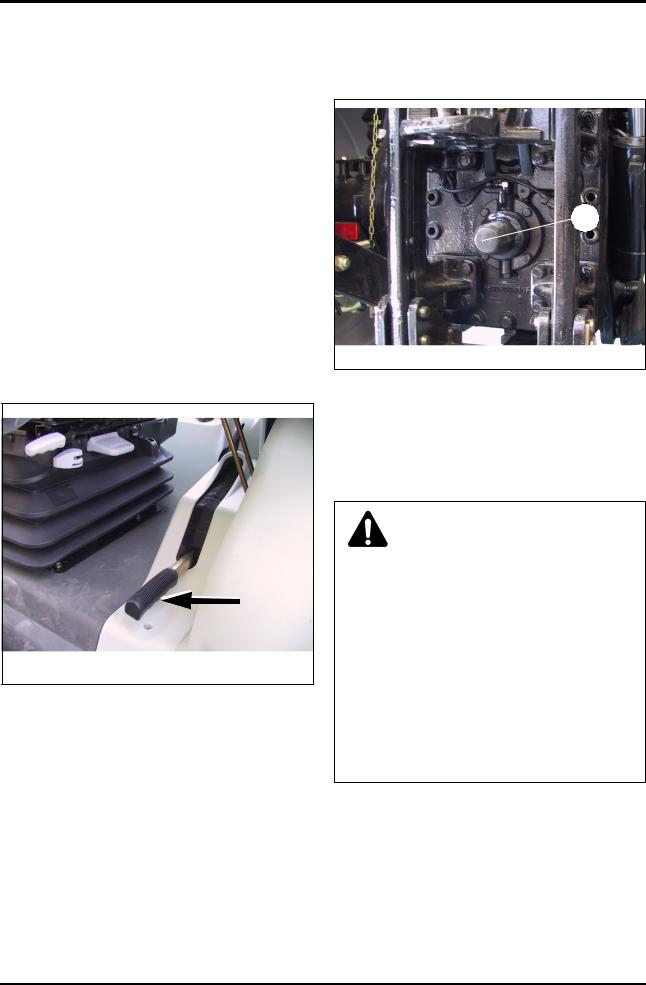
2 . INTRODUCTION - SAFETY INSTRUCTIONS AND WARRANTY
•If your tractor is bogged down in mud or frozen to the ground, DO NOT attempt to drive forward. The tractor can rotate around its rear wheels and overturn. Lift any attached implement and attempt to BACK OUT. If this is not possible, tow it out with another vehicle.
•If you get stuck in a ditch, BACK OUT, if possible. If you must go forward, do so slowly and carefully.
•A bare tractor or tractor with rear mounted attachments should be backed up the slope in reverse and travel forward downhill.
•A tractor with a loaded front-end bucket should be backed down the slope and travel forward uphill. Keep the loader bucket as low as possible.
•Always keep the tractor in gear when going downhill. DO NOT PERMIT the tractor to coast with clutch disengaged or transmission in neutral.
2.13.7 - Emergency handbrake
IMPORTANT: If the brakes fail and in an emergency situation, use the emergency handbrake located to the left of the driver (Fig. 14)
Z3A-780-07-04
Fig. 14
DANGER: Do not use the emergency handbrake as a parking brake. The parking brake to be used is the "ParkLock" brake control on the steering wheel.
IMPORTANT: If the brakes fail, contact an approved AGCO dealer to have them repaired.
2.13.8 - Other risks
•Ensure that the PTO shield (1) is in place when the PTO driveline is not in use (Fig. 15).
 1
1
Z3A-740-07-04 |
Fig. 15 |
|
•Before attaching, detaching, cleaning or adjusting PTO driven implements, disengage the PTO, stop the engine, remove the ignition key, and make sure that the PTO transmission shaft has stopped.
•Ensure that all the PTO transmission shaft guards and shields are in place and check the presence of all safety decals (Fig. 16).
DANGER
Z2-541-05-03
Fig. 16
•Be sure everyone is clear of your machine before engaging the PTO. For stationary PTO operation, always place transmission control lever in neutral, engage handbrake, and chock both tractor and implement wheels.
•When operating mobile PTO driven equipment, DO NOT leave the tractor seat until the PTO drive is disengaged, the transmission is in neutral, the handbrake is engaged, the engine shut off and the ignition key removed.
2.16 |
8400 EAME |

2 . INTRODUCTION - SAFETY INSTRUCTIONS AND WARRANTY
•DO NOT use PTO adapters, reducers or extensions as they extend the PTO coupler and universal joint out beyond the protection offered by the PTO shield.
•The deployment of drawbars and lift rods must not allow the threads to show.
DANGER: DO NOT attempt to unplug the hydraulic connections, or adjust an implement with the engine running or the PTO drive in operation. To do so may result in seri-
ous injury or death.
•When using chemicals, carefully follow the chemical manufacturer’s instructions for use, storage and disposal. Also follow the chemical application equipment manufacturer’s instructions.
•When operating under poor visibility conditions, or in the dark, use your tractor work headlights and reduce your ground speed (DO NOT use your work headlights when travelling on a roadway because rear pointed white lights are illegal except when reversing and may confuse following drivers).
•Operate your tractor with tyres of suitable width, consistent with the particular task you are performing. To adjust tyre width, see chapter Maintenance and Adjustments.
•Reduce your speed when operating over rough or slippery ground and when foliage restricts your view of hazards.
•DO NOT make sharp turns at high speed.
2.13.9 - Implements and attachments
WARNING: A front-end loader (bucket or forks) must be equipped with a suitable holding device to prevent the load (bales, fence posts, rolls of fence, wire etc.) from rolling
down the lift arms into the driver’s compartment and crushing the driver when the loader is raised. Inadequately secured objects could also fall and injure bystanders.
•Three-point hitch and side mounted implements make a much larger arc when turning than towed equipment-. Make certain to maintain sufficient clearance for turning. Use only AGCO approved equipment.
•When using attachments or implements with the tractor, be sure to read and understand the instructions in the Operator Instruction Book for that attachment or implement and follow its safety instructions. Use only AGCO approved attachments and implements.
•DO NOT overload a towed attachment or equipment. Use proper counterweights to maintain tractor stability. Hitch loads to the drawbar only.
•A transport chain 1 will help control drawn equipment should it be accidentally separated from the drawbar while transporting. Using the appropriate adapter parts, attach the chain to the tractor’s safety chain anchor or any other specified anchor point. Provide only enough slack in the chain to permit turning. Contact your AGCO dealer for a chain of equal or greater strength than the weight of the trailed implement (Fig. 17).
•Ensure that all trailed implements are fitted with a safety chain linking the tractor to the implement, if required by law (Fig. 17).
•Pull only from the approved drawbars. Towing or attaching to other locations may cause the tractor to overturn (Fig. 18).
2
1
Z2-542-05-03
Fig. 17
Z2-543-05-03
Fig. 18
8400 EAME |
2.17 |
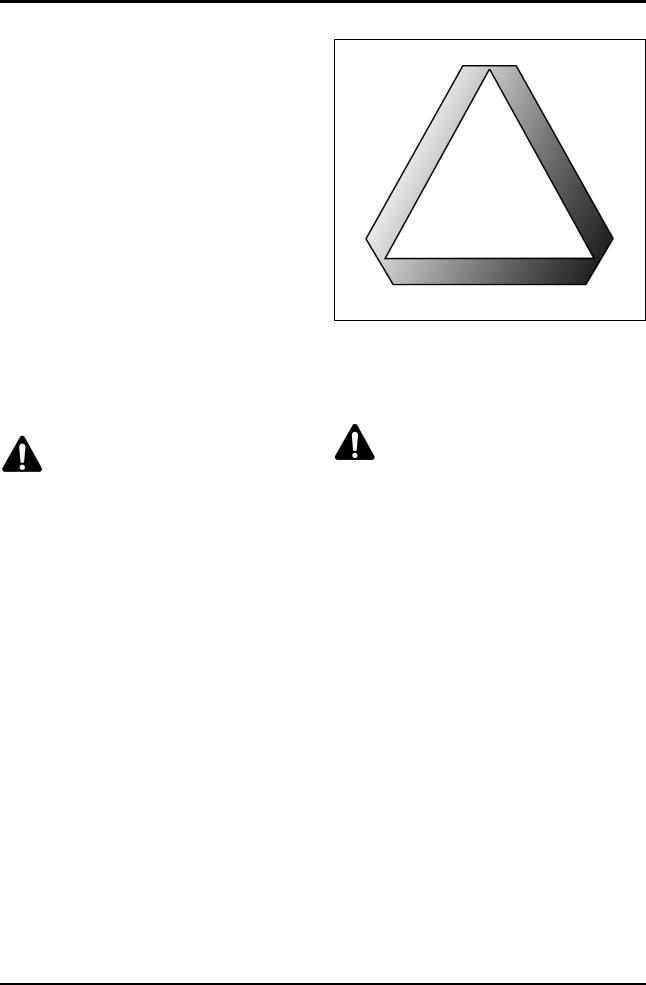
2 . INTRODUCTION - SAFETY INSTRUCTIONS AND WARRANTY
2.13.9.1 - Safety measures when towing
•For towed equipment WITHOUT brakes, DO NOT tow equipment:
-at speeds exceeding the speed limits in force in the relevant country,
-at a maximum load higher than that indicated on the name plate.
•For towed equipment WITH BRAKES, DO NOT tow equipment:
-at speeds exceeding the speed limits in force in the relevant country,
-at a maximum load higher than that indicated on the name plate.
NOTE: The tractor requires correct trailer braking system installed and connected to the equipment.
Stopping distance increases with speed and weight of towed loads, and on hills and slopes.
Towed loads with or without brakes that are too heavy for the tractor or are towed too fast can cause loss of control. Consider the total weight of the equipment and its load.
2.13.10 - Tractor Towing
See chapter 4.
WARNING: Towing: the following instructions must be followed when towing:
If the engine is not running:
•Maximum towing speed: 10 kph.
•Maximum towing distance: 8 km.
If the engine is running:
Towing speed is identical to that of a trailer without brakes at the speed authorised by legislation in force in the country concerned.
2.13.11 - Road use
Take the following precautions before using the tractor on a public road.
•Respect national laws and local regulations in force relating to tractor use.
•Lock the brake pedals together.
•Place all implements in transport position and lock.
•Place all implements into their narrowest transport configuration.
•Disengage the PTO and differential lock.
•Make sure any required clearance flags or hazard warning lights are in place and in working order.
•Clean off all reflectors and road lights, front and rear, and be certain they are in working order.
•Ensure that the tractor and equipment are fitted with emergency warning triangles and other markings recommended to improve visibility when driving on roads, unless otherwise indicated (Fig. 19).
Z2-544-05-03
Fig. 19
2.13.12 - Highway code
When operating your tractor on a public road the following precautions must be taken.
WARNING: NEVER allow any persons to ride on the tractor or towed equipment.
•Know the road you are going to travel.
•Turn on hazard warning lights when travelling on roads, day or night, unless prohibited by law.
•Take care when towing a load at transport speeds, especially if the towed equipment is NOT fitted with brakes.
•Observe all local or national regulations regarding the road speed of your tractor.
•Use extreme caution when transporting on snow-cov- ered or slippery roads.
•Wait for traffic to clear before entering a public road.
•Beware of blind intersections. Slow down until you have a clear view.
•DO NOT attempt to pass at any intersection.
•Slow down for turns and curves.
•Make wide, gentle turns.
•Signal your intent to slow, stop or turn.
•Shift to a lower gear before going up or down hills.
•Keep tractor in gear. Do not coast with the clutch disengaged or transmission in neutral.
•Stay out of the path of oncoming traffic.
•Drive in your correct lane keeping as near to the curb as possible.
•If traffic builds up behind you, pull off the road and let it go by.
•Drive carefully. Anticipate what other drivers might do.
•When towing a load, start braking sooner than normal and slow down gradually.
•Watch out for overhead obstructions.
2.18 |
8400 EAME |
